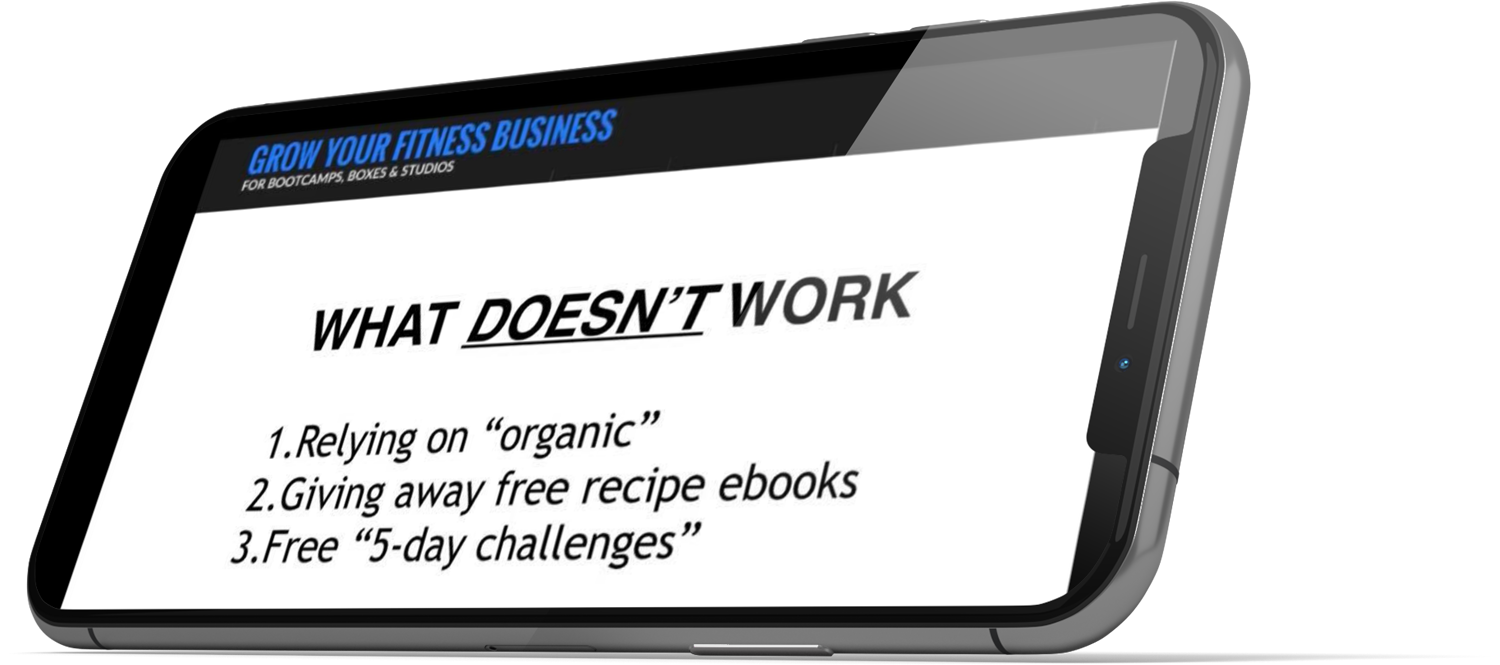
Here’s the method we use to grow by at least 40 new paying clients every single month and scale our studios to £20k/mo revenue within weeks.
Several of my Mentorship clients (like Tracey, above) are also following this formula to get similar results.
Its also a way to offer huge value to your local area & be seen as the “go-to” authority.
It’s a Fitness Challenge.
It works really well because it overcomes the two biggest obstacles prospects will have before joining – time, and money.
We found that a program between 21 days and 6 weeks is short enough for people to give it a solid try. . . and also just long enough for them to see real results & get hooked on the program.
I believe it also works because it doesn’t sound like “a trial”, which can be off-putting.
Instead, this Front End Offer (FEO) stands alone as a true, self-contained, results-driven package.
Meaning the client can experience a tangible result by the end of it.
Think about it – most prospects are skeptical that they can get results with anything less than 4 weeks. And anything over 6 weeks is too much commitment for people that don’t know how awesome you are (yet).
This offer works by being the right length and level of commitment.
This walk-through will teach you all the steps to launch your fitness challenge offer, how to fill it with excited new prospects, and how to convert the majority of those people into long-term, high paying clients.
This system increases your monthly recurring revenue (MRR) by thousands each month. And at the same time it gives you £4000 – £10k+ in front end sale revenue on top!
Specifically, here are the steps you’re going to find out in this guide:
- Who Should Use This Method (And Whose Best Avoiding It)
- How to Package & Price Your Offer
- How to Fill The Spots On Autopilot With Facebook Ads
- How to Upsell Clients Into Your Long-Term Membership – During The First Week of The Program
- How to Evaluate The Numbers & Costs For Your Marketing Funnel
 Just before we get started, check out the FREE Fitness Business Diagnostic.
Just before we get started, check out the FREE Fitness Business Diagnostic.
In just a few minutes it will evaluate your business & tell you exactly where you’re leaving thousands of pounds unclaimed.
You’ll get a customized prescription based on where you are, and exact steps you can take to move your business forward quickly.
1.Who Should Use This Method?
This system is best for:
- Large group coaches / outdoor bootcamps
- Semi-Private and PT studios
- Group studios and boxes (such as Crossfit, F45 etc)
This system is best if you have capacity for at least 50+ new clients. If you only have space for 3 new clients… this isn’t the strategy for you!
In that case you’d be better off using a lower maintenance lead magnet such as a free consult, or free training week, because you won’t need as many people, nor need to make such a fuss.
However, if you have capacity to fill your studio facility with 10, 20, 0r even 30+ new monthly clients, a group based challenge program like this is ideal.
2. How to Package & Price Your Front End Offer
A big mistake coaches make when they create offers like this is actually giving too much.
They overload it with features & shiny objects that overwhelm the prospects – lowering its perceived value instead of raising it.
I like to use the Minimum Effective Dose (MED) for any package I create. We want the client to get the maximum results with minimal investment of time or learning on their behalf.
So you’re the expert here…
Start with what specific result can you help a client achieve? What results do your clients rave about in the first few weeks with you?
(As a guideline, in our gyms we can usually help a prospect drop a dress size, or at least 10-15lbs safely in 6 weeks. That’s why we’ve become famous for our 6-Week Transformation Challenge).
Start with the end goal in mind, and package everything towards that outcome – after all, your clients will pay more for results.
I’ve run numerous variations of this program.
I’ve launched a “6–Week Bikini Body Challenge”.
A “21-Day Belly Blast”.
A “28-Day Metabolic Kickstart”
Make sure to name it something that’s catchy, and appeals to your target market.
Note that it doesn’t have to be called a “challenge” either. Thats just a name, more than a structural component.
Personally, these front-end trial programs are simply my regular bootcamp / large-group style training. The challenge clients will jump in with my regular clients. But they will have beginner-level regression exercises to complete.
So it just runs alongside my actual weekly program. The new challengers also get some out-of-session bonuses and features specific to them. But the workouts themselves are my regular large or small group sessions.
“How much should I charge?”
Most coaches price completely wrong.
Because they base their pricing strategy on nothing more than ego (a self-perception of worth). But this doesn’t make it a fiscally-sound business decision.
The key to get your pricing right is first to look at what is your end outcome here? Because we’re not trying to make our profits on the challenge.
The goal is to gain a certain number of long-term monthly clients AFTER the Front End Offer is over.
So don’t get hung up on making loads of cash upfront.
What we do need to be concerned about are four things with regards to pricing:
- Are we charging enough so that the client values what they’re paying for? If you charge too little, there’s not enough financial nor emotional investment, and the client may drop off. We want to charge a relative amount that will attract serious buyers, while still seeming like a great special offer.
- Are we covering costs of delivering the program? You have time away from your regular clients to consider. Any materials you might produce for the program (manuals, Facebook groups etc), and also your payroll to deliver it. The other expense is your advertising, such as Facebook or Google (we’ll talk about that soon).
- The “Cost” of The Turnaround Time Before Converting FEO Buyers into Long-Term Clients: “Turnaround time” is a critical – yet overlooked – aspect of your marketing campaigns. Remember, you’re investing in advertising upfront to get sign ups… yet you may not make back the money for a couple of weeks. Can you afford to go negative on your upfront investment, and if so, for how long? Your price may need to be high enough to bring back money and “liquidate” the costs of filling / delivering the program before any back-end conversions are made.
- The Comparative Price of Your Long-Term Packages: Obviously, the intro offer needs to make sense compared to your regular offering. If your regular month-to-month option is £99/month, then it makes no sense if your 21-day program is $219… or $27. These prices would be too high & too low – respectively – compared to your regular rate.
Consider these 4 factors.
It’s impossible for me to pull a random number out of a magic hat and say “Charge this much!” as that would be irresponsible of me, without knowing your exact business, goals, budget or assets.
If you would like me to help you do this on a personal level, read GO HERE to learn how we’ll work together 1-1 to set up your FEO & Facebook ads campaign.
When I began offering Fitness Challenges 10 years ago, I charged only £99 per month.
But the more I proved the offer and got results for people, my confidence increased. And so did my prices along with it.
Currently, all of our 25 studios grow by promoting the 6-Week Challenge. We charge a minimum of £299 in most areas. Some of our studios in more affluent areas (such as London) charge £599 for the 6-weeks.
And we close 60-80% of the prospects we offer it to at those prices.
One of my mentoring clients, Tracey – who runs IronGirlz in California – is running a 21-day challenge. And she sells out her spots every time using the funnel I helped her create.
Tracey has run 3-4 challenges now to keep optimising and tweaking the system, making it more profitable each time.

What she’s saying here is that on the newest challenge we dropped the Cost Per Lead (21-day challenger)down from $19 to only $10.
The Cost Per Sign Up is the what we’re paying to convert a challenger into a monthly client (Tracey’s program is $180/month). So $34 to get a client paying back $180 a month. That’s a damn good ROI 🙂
As you’ve likely guessed from this conversation so far… the real key is how well can you convert challengers into long-term clients?
And that’s really what it’s all about. There’s no use putting 100 challengers into a program if none of them become long-term monthly clients on EFT recurring revenue.
In just a moment, I’ll show you some ways to ascend challengers into long-term high paying clients.
But first, I’m sure you’re chomping to know how to run Facebook ads to fill those spots up and suck in those leads, right?
3. How to Fill The Spots On Autopilot With Facebook Ads
People fuss a lot over the Facebook ad. But the real ‘secret’ is to create an offer so good it sells itself.
If you’ve positioned, packaged and priced your offer really well, your advert will get clicks.
To get plenty of clicks on your advert, start with the IMAGE.
The image on the Facebook ad is 80% of its success – because it either grabs your prospect’s attention, or it fails to.
Here are some Facebook ad image do’s and don’ts:
✅ Show images of happy clients
✅ Emphasise the experience – the community vibe that shows your place is welcoming and friendly
✅ Use colours that contrast with Facebook’s white / blue colour scheme. Oranges and reds work well to catch the eye.
✅ You can add text to the image so long as it doesn’t take up more than 20% of the space. So use that text wisely! State a BENEFIT not a feature. For example, “fast weight loss” is a better benefit than “exercise program”.
❌ Do NOT show your clients sweating, in pain, and about to vomit after a set of 100 burpees.
❌ Be careful showing images of Instagram fitness models with 8-packs & mega thighs. It might not be as appealing as you think to your audience, if you’re targeting the everyday busy mum. I love Michelle Lewin as much as the next guy… but a friendly image of a ‘normal’ female always performs better because its more relatable.
If you’re not sure, check out Slimming World and Weight Watchers advertising. Criticise their product all you like, but their marketing destroys yours.
Next, create some ad copy for the text.
Keep it focused on the prospect and the benefits they’ll receive.
See real examples of our best-performing Facebook Ads in this free course >> Get it here





